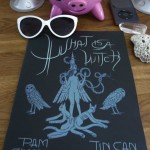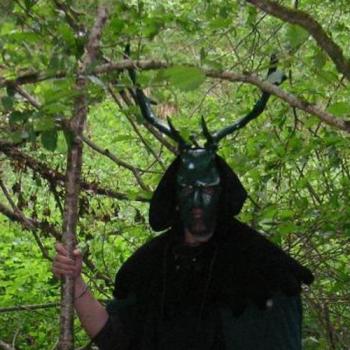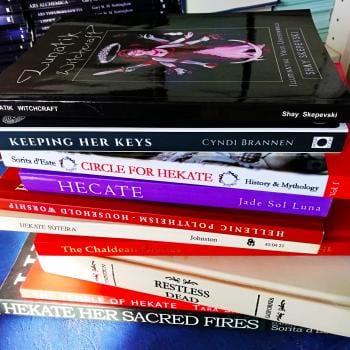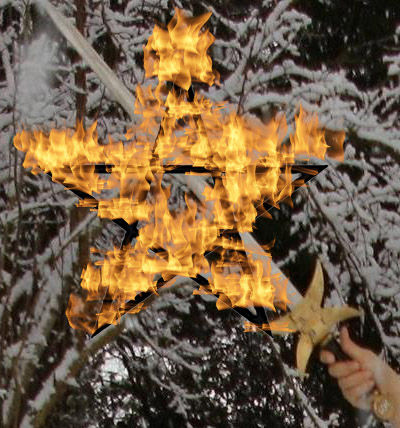 A debate on the symbol so very much associated with modern Pagan traditions today, prompted me to dig out a copy of the 2008 book WICCA: Magickal Beginnings which I co-authored with David Rankine. In the book we seek to find the possible origins for many of the different ceremonial aspects found in initiatory Craft and in subsequent traditions which borrowed and grew from it.
A debate on the symbol so very much associated with modern Pagan traditions today, prompted me to dig out a copy of the 2008 book WICCA: Magickal Beginnings which I co-authored with David Rankine. In the book we seek to find the possible origins for many of the different ceremonial aspects found in initiatory Craft and in subsequent traditions which borrowed and grew from it.
This is an extract from Chapter 16, “The Pentagram” in which we explore the different historical uses of this symbol:
The pentagram has become a symbol which is used to represent the Wiccan tradition, as well as a number of other modern Pagan traditions in more recent times. In the tradition of Wicca it is taken to represents the four elements – Air, Fire, Water & Earth – in perfect balance thereby creating the fifth element, that of Spirit. These elemental attributions can be traced back to at least ancient Greece.
However in the past the association of the pentagram with witchcraft was basically a negative one, serving in an apotropaic manner to protect from the devil and witches. Thus in Germany in the 1820s we find its use described in an amuletic manner:
“on these mountains on the night of the thirtieth of April, the witches, with the fallen spirits, held a great festival, a witch demoniac carousal … on that night they make a pentagram on the threshold of their doors, to prevent his satanic majesty, or any of his imps, from entering their houses.”[i]
This theme is mirrored in Goethe’s Faust, where the pentagram is a protection from demons and devils, which Mephistopheles complains to Faust about.
“Mephistopheles: Remove that parchment, and the path is plain.
Faust: Oh, ‘tis the pentagram that gives you pain.”
This idea was not restricted to Germany, as can be seen by the following example, taken from a story reproduced in two different women’s magazines of the late 1830s in England:
“The dog, or rather the devil, could not escape through the door, on account of a pentagram described upon the threshold; this figure, “the Druid’s foot,” “sive salutis signum,” being a bound which spirits cannot pass without permission.”[ii]
Indeed the pentagram was being used as a Christian symbol long before it was associated with witchcraft. It was linked to the wounds of Christ, and also referred to in the third century Jewish proto-grimoire, the Testament of Solomon.
“The above mark [pentagram] was heretofore used as the signe of the + is now, that is, at the beginning of letters or bookes, for good luckes sake: and the women among the Jews did make this mark on the childrens chrysome cloathes. – Aubrey MS [1686] – This figure (observes Bishop Kennett, in the margin of the same MS.) of three triangles intersected and made of five lines, is called the Pentangle of Solomon; and when it is delineated on the body of a man, it is pretended to touch and point out the five places wherein our Saviour was wounded. And, therefore, there was an old superstitious conceit, that this figure was a fuga demonum: – the devils were afraid of it.”[iii]
The Sumerians were already using the pentagram by 3000 BCE. They called it Ub, meaning ’region’, ’direction’ or ’heavenly quarter’. Interestingly the Sumerians often drew their pentagrams inverted. The Sumerians used a five direction system of East, South, West, North and Above, with Above corresponding to the goddess Inanna, so it has been speculated that these directions were attributed by them to the pentagram.
In ancient Greece, the Pythagoreans called the pentagram Ugieia, meaning ’soundness’. They wrote the letters around the points of the pentagram, but as there were six in the word they combined the epsilon (e) and second iota (i) to make a theta (th) which looks the same as the two vowels combined. They thus labelled the points of the pentagram with the letters upsilon (U), gamma (G), iota (I), theta (Th), and alpha (A). These are also the first letters of words corresponding to the elements. Thus we have Hudor (Water),[iv] Gaia (Earth), Hierion (divine or holy thing, i.e. Spirit),[v] Therma (Heat i.e. Fire) and Aer (Air) corresponding to the points of the pentagram.
These attributions started at the top and went anticlockwise around the pentagram, giving this set of attributions:
| Point | Greek | GD/Wicca |
| Top | Water | Spirit |
| Upper left | Earth | Air |
| Lower left | Spirit | Earth |
| Lower right | Fire | Fire |
| Upper right | Air | Water |
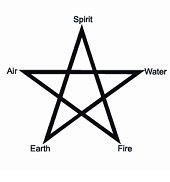
(Contemporary Wiccan attributions of the elements to the pentagram)
The Greek letters can be seen drawn around an inverse pentagram in Agrippa’s Three Books of Occult Philosophy, showing that this idea was recognised and used in the sixteenth century.
When did the attributions change from the ancient Greek ones to those used in modern magic? The answer may well lie with the Elizabethan magus Dr John Dee. The Great Table of Dee’s Enochian system is comprised of the Four Elemental Tablets (or Watchtowers) combined. The sequence of their combination is relevant for the elemental attributions, as we can see the elemental attributions applied to the pentagram were clearly derived from here.
When creating the Great Table, the top half (or row) is formed by placing the Tablet of Air on the left and the Tablet of Water on the right, as you look at it. Likewise the bottom half (or row) is formed by placing the Tablet of Earth on the left and the Tablet of Fire on the right. If you then read anticlockwise from Air in the top left, the sequence is alphabetical, proceeding to Earth in the bottom left, Fire in the bottom right and Water in the top right, exactly as is seen with the elemental attributions on the points of the pentagram (with Spirit at the top).
The wearing of a pentagram ring, popular amongst Wiccans and pagans today, has a precedent in the third century CE Testament of Solomon. In this work King Solomon was given a ring bearing the pentalpha (pentagram) by the archangel Michael to compel the obedience of demons who he summoned to build the temple in Jerusalem. Descriptions of the ring also refer to it having four gems representing the elemental archangels embedded in it.
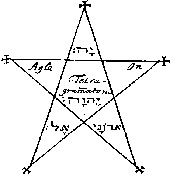
(The engravings of the pentagram ring used in the grimoire tradition, this example from Sloane MS 2731 – Lemegeton)
The inverse pentagram, associated in the Wiccan tradition today with the second degree as a symbol of the face of the horned god can be found in Crowley’s writings, drawing from The Key of the Mysteries by Eliphas Levi (1861):
“The flaming star, which, when turned upside down, is the hieroglyphic sign of the goat of Black Magic, whose head may then be drawn in the star, the two horns at the top, the ears to the right and left, the beard at the bottom.”
In the ritual of the “Mark of the Beast”, Crowley made reference to the inverse pentagram with respect to the goat-headed god Baphomet, inspired by Levi’s Goat of Mendes, when he wrote, “About me flames my father’s face, the star of force and fire.”[vi] It is also interesting to observe the use of the inverse pentagram for second degree elevation when considering the Sumerian link, with the single point being associated with the goddess Inanna, whose descent to the underworld also inspired part of a mystery play which traditionally forms part of the second degree initiation ceremony.
Much has been said about the use of the pentagram in Christianity and in Freemasonry and how that may have contributed to its use and popularity within modern Wicca. However, here it is necessary to mention that the five-pointed star as the endless knot can be found in use all over the world, throughout history at one time or another and as such it is not important here in this context beyond what has already been discussed. The pentagram has always been a powerful symbol, and is likely to continue to be so.
[i] Travels in the North of Germany: In the Years 1825 and 1826, Dwight, 1829
[ii] The New Monthly Belle Assemblée, Rogerson, 1838 and The Ladies’ Cabinet of Fashion, Music & Romance, Henderson, 1839
[iii] Time’s Telescope for 1826, 1826
[iv] The H is added to the beginning of the word in transliteration from the Greek, so it actually starts with the letter U (upsilon).
[v] Again the H is added in transliteration, so the word starts with the letter I (iota).
[vi] Magick, Aleister Crowley, 1929
This article is an extract from the 2008 edition of WICCA: Magickal Beginnings by Sorita d’Este and David Rankine, published by Avalonia.

